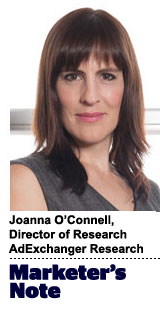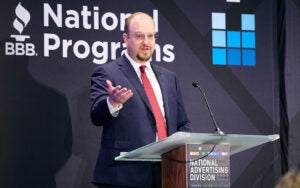 “Marketer’s Note” is a weekly column informing marketers about the rapidly evolving, digital marketing technology ecosystem. It is written by Joanna O’Connell, Director of Research, AdExchanger Research.
“Marketer’s Note” is a weekly column informing marketers about the rapidly evolving, digital marketing technology ecosystem. It is written by Joanna O’Connell, Director of Research, AdExchanger Research.
There was a great deal of talk at last week’s two-day Industry Preview conference about the necessity of delivering more relevant experiences in a world that’s increasing wired and multi-device. (The New York Times’ Nick Bilton talked at length about new connected technologies – including a growing range of wearables – that are either available today or just around the corner.)
Speakers generally agreed that what’s needed most to enable more effective, relevant marketing is change management. Many companies continue to rely on outmoded organizational models and dated assumptions about the roles of “advertising” and “marketing,” rather than structuring themselves around “people” (aka customers, current and future). As Brad Rencher, SVP and GM of Adobe’s digital marketing business unit, aptly stated, “We must bridge the church and state of advertising and marketing.” I couldn’t agree more.
I presented some initial topline findings from my “customer lifecycle management” research on day one of the conference. (Quick background: I am exploring whether and how companies are migrating to a model of 1:1 communication across a consumer’s purchase lifecycle.) Among the early insights is this: Organizations face myriad challenges in moving to a data-driven model of customer-centric marketing, not least of which is cultural – and, as often follows – organizational change. In fact, in my many conversations with marketers (who represent a wide range of industry verticals including CPG, financial services, telco, retail, pharma and more) this was a big, pervasive theme: organizational realities inhibit customer-centric behavior.
To give a flavor of this, I shared the following quotes, which demonstrate some common, related issues:Customer-centricity is not explicitly incentivized: “At bigger companies organizations are siloed, so different parts own different pieces of the customer journey and there are no incentives to collaborate.”
Brands operate as independent fiefdoms: “The global consumer marketing organization formed out of constituent lines of business. Different LOBs were different in their willingness to give up certain things.”
User-level information (certainly in anonymous contexts) is not shared: “We don’t yet know that Brand A might be targeting the same user with display that I am targeting in a CPA deal. Even in search – we’re buying all the same keywords.”
Marketing and IT are not aligned: “The tech group that ultimately would implement that is part of a different org. It’s IT right now. We’re still using relational databases. In the future we need to go more raw. Getting that prioritized and executed when it’s in a different org is a challenge.”
Organizational roadblocks are not the only things standing in the way of customer-centricity. Technology issues, privacy concerns and the ROI question loom large, among others. But, I’m finding many examples, big and small, of progress, which I am excited both to find, and to surface. I am working on the full report now. Stay tuned.
Joanna
Follow Joanna O’Connell (@joannaoconnell ) and AdExchanger (@adexchanger) on Twitter.













